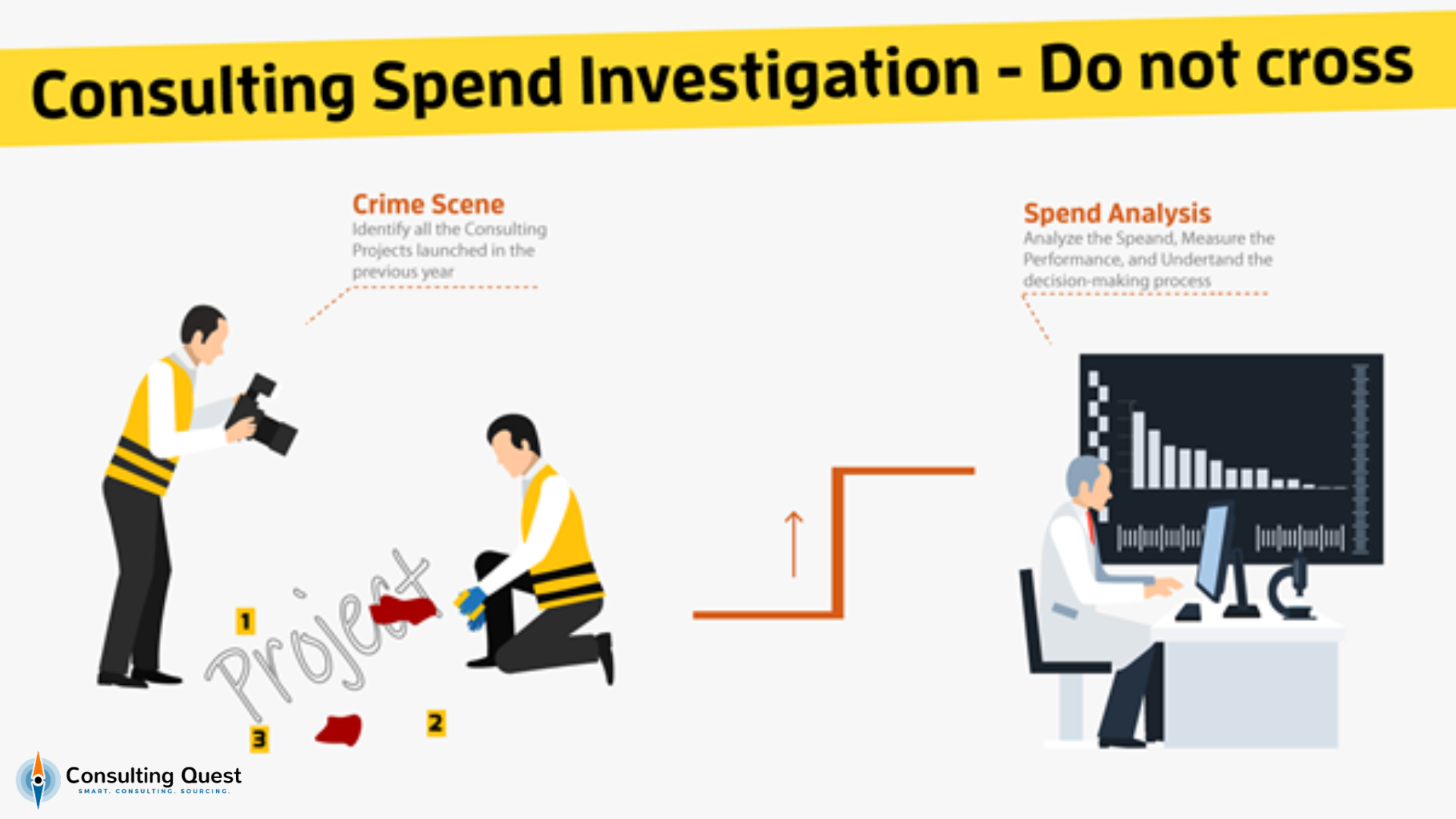Índice
If you’re reading this, chances are you suspect there’s room to improve how your organization buys and uses consulting. Maybe your spend feels fragmented. Maybe decisions happen in silos. Or maybe you’re simply unsure if you’re getting the value you should from your providers.
Here’s the good news: you don’t need a massive transformation program to get started. The very first step is surprisingly accessible—and surprisingly powerful.
It all starts with your data.

To embark on a journey toward better consulting procurement—whether your goal is tighter cost control, better outcomes, or both—you need to understand three things:
- How much you’re spending, who is spending it, and on what.
- How decisions are being made, from inception to selection.
- What impact you’re getting, and whether your consulting partners are delivering on their promises.
This is where our Consulting Performance Scanner comes in. It’s a structured framework designed to help you assess your consulting spend, evaluate your internal procurement behaviors, and unlock meaningful insights—fast.
As Carly Fiorina once said:
“The goal is to turn data into information and information into insight.”
Let’s dive in and explore how to transform scattered spend data into a strategic lever for growth.
How Much You’re Spending, Who Is Spending, and on What
Before you can improve your consulting procurement, you need a baseline. That means understanding not only how much you spend on consulting—but who’s spending it, why, e what they’re buying.
This isn’t just an accounting exercise. It’s a strategic scan that reveals spending patterns, identifies inefficiencies, and lays the groundwork for targeted improvements.
Start with the Basics: Your Spend Overview
Begin by collecting data from the previous fiscal year, using sources like:
- Invoices and purchase orders
- Supplier databases and past RFPs
- Project documentation and internal interviews
Your goal is to normalize and consolidate the information across units and geographies.
The Four Key Dimensions (with Tables)
Each dimension gives you a different lens to view your consulting activity. Together, they form the foundation for a comprehensive consulting performance assessment.
1. Financials: Understand the Scope
Start by quantifying the total consulting spend across your organization—this sets the stage for deeper analysis.
| Metric | Description | Why It Matters |
| Total Consulting Spend | Aggregate amount spent on consulting last fiscal year | Establishes baseline for analysis |
| Spend as % of Revenue | Total spend relative to overall business income | Helps determine strategic significance |
| Spend per Business Unit | Break down spend by division/function | Reveals where most consulting occurs |
| Avg. Project Cost | Total spend divided by project count | Identifies variability and efficiency |
| Potential Savings | Estimate impact of 20–30% optimization | Creates urgency and value case |
2. Users: Who Is Buying Consulting?
Next, look at who within the organization is buying consulting services—and how often. This reveals buying behaviors and internal demand centers.
| Data Point | What to Capture | Insight Gained |
| Buyer Function | Marketing, Finance, Ops, etc. | Shows which teams rely most on consulting |
| Project Sponsors | Names/roles of recurring sponsors | Maps influence and decision-making hubs |
| Frequency | # of consulting projects per team/year | Highlights active vs. low-usage units |
| Type of Consulting | Strategy, Ops, Digital, HR, etc. | Tracks capability demand across units |
3. Projects: What Are You Buying?
Analyzing the nature and structure of your consulting projects helps you evaluate strategic alignment, reuse, and gaps in topic coverage.
| Attribute | Description | Key Questions |
| Project Objectives | What was the problem to solve? | Were they aligned with strategic goals? |
| Length | Weeks/months | Are some projects dragging or too brief? |
| Project Sequels | % of follow-on projects | Indicates lack of internalization or over-reliance |
| Topic Gaps | Unaddressed topics | Where should you be using consulting more or less? |
4. Suppliers: From Whom Are You Buying?
Finally, evaluate the supply side—your consulting firms—so you can optimize your panel, diversify strategically, and improve pricing discipline.
| Attribute | Description | Insight Gained |
| Top Suppliers | Most frequently used firms | Evaluate ROI per supplier |
| Firm Profile | Tier-1, Boutique, Specialist, Local | Match supplier type to project needs |
| Engagement Breadth | How many BUs each supplier works with | Identifies cross-unit leverage potential |
| Pricing Consistency | Rates across regions/functions | Check for inefficiencies or disparities |
🧠 Quick Win: Identify Outliers and Gaps
Once this table-driven scan is complete, look for:
- Units with outlier spend levels
- Consultants charging premium rates inconsistently
- Redundant topics or duplicated scopes
- Gaps where high-priority topics lack consulting support
Even without launching a transformation, this analysis can unlock quick, visible savings and build the internal momentum for deeper change.
How Decisions Are Made from Inception to Selection
Knowing how much you spend is only half the equation. To truly improve your consulting procurement, you must understand como as decisões são tomadas—from the moment a need is identified to the moment a supplier is chosen.
Why does this matter?
Because unclear processes, invisible validations, and inconsistent stakeholder involvement lead to inefficient sourcing, higher costs, and poor outcomes. Mapping your decision workflows helps you spot bias, streamline approvals, and bring transparency to your consulting procurement process.
For a step-by-step approach to setting up effective consulting purchases, check out our complete guide to buying consulting services; ideal for procurement leaders ready to elevate their sourcing practices.
Decision-Making Analysis Framework
Structure your analysis into four phases, capturing who is involved, como as decisões são tomadas, e whether procurement plays a role.
1. Inception: How Projects Are Initiated
Understanding where and why consulting needs originate is key to identifying demand drivers—and potential misuse.
| Attribute | What to Capture | Key Questions |
| Project Trigger | Strategy need, crisis, resource gap | Why was this project launched? |
| Initial Buyer | Who first voiced the need? | Are projects initiated bottom-up or top-down? |
| Justification | Business case, benchmarking, urgency | Was there a clear rationale or just intuition? |
2. Collaboration: Stakeholder Involvement
Consulting procurement is not a solo act—mapping stakeholder engagement shows where alignment or friction occurs.
| Attribute | What to Capture | Key Questions |
| Procurement Involvement | Was procurement consulted? At what stage? | Are we enabling or bypassing strategic sourcing? |
| Other Stakeholders | Finance, HR, IT, legal, strategy | Were cross-functional perspectives considered? |
| Timing of Engagement | Before, during, or after supplier contact | Are we catching projects early enough to influence? |
3. Decision-Making: Approvals & Budgeting
Tracking who approves what—and based on which criteria—helps you evaluate governance maturity and risk exposure.
| Attribute | What to Capture | Key Questions |
| Budget Holder | Who owns the budget? | Is it the same person as the project sponsor? |
| Final Decision-Maker | Executive, team, committee | Who makes the call, and is it documented? |
| Approval Criteria | Price, speed, reputation, prior relationship | Are decisions based on fit and ROI—or habit? |
| Validation Layers | Formal sign-offs, policy thresholds | Are policies consistent across business units? |
4. Sourcing: Competitive Dynamics
Your approach to competition directly affects pricing, innovation, and value—so it’s critical to analyze your sourcing discipline.
| Attribute | What to Capture | Key Questions |
| Competition Held | Was a competitive bid organized? | If not, why not? Was urgency the reason or preference? |
| Number of Bidders | Actual proposals received | Is the shortlist too narrow or too broad? |
| Thresholds for Competition | When are competitive bids required? | Are rules enforced or often waived? |
| Use of Preferred Suppliers | Was the choice from a vetted panel? | Are we optimizing pre-negotiated contracts? |
Want to build stronger RFPs that attract the right consulting partners and drive better results? Our RFP for Consulting Made Easy guide breaks down exactly how to do it—with tips, templates, and checklists.
💡 Insights and Opportunities
When you visualize these phases across projects, patterns emerge:
- Procurement is often involved too late to impact value.
- Validations may be skipped or inconsistent, especially under pressure.
- Project justifications may rely more on internal politics than strategic value.
- Supplier selection may be influenced by habit, reputation, or urgency—not fit or performance.
🧠 Quick Win: Define a Consulting Sourcing Playbook
Based on your findings, begin crafting a sourcing playbook that includes:
- When procurement must be involved
- Clear criteria for competitive sourcing
- Thresholds and exceptions that are realistic, but enforceable
- Decision-making roles and RACI (Responsible–Accountable–Consulted–Informed) charts
This gives your organization a repeatable and transparent process, improving both control and outcomes without slowing down execution.
What Benefits You Are Getting from Your Projects and Providers
So far, you’ve identified what you’re spending, who is spending it, e como as decisões são tomadas. But none of that matters if you can’t answer the most critical question:
Was it worth it?
Evaluating the value and impact of your consulting projects—and the performance of your consulting firms—is essential to ensure your investments are delivering real business results. This step moves your procurement function from gatekeeper to value enabler.
The Three Dimensions of Performance Evaluation
Each dimension helps you measure a different angle of consulting ROI: the structure of the engagement, the consultant’s execution, and the actual business outcome.
1. Project Characteristics: The Setup
Understanding how the project was scoped, staffed, and priced helps establish whether the conditions were right for success.
| Attribute | What to Capture | Why It Matters |
| Purpose & Scope | What was the goal and boundary of the project? | Helps align value expectations with intent |
| Project Length | Duration in weeks/months | Gauges scope complexity and budget match |
| Pricing Structure | Flat fee, T&M, performance-based | Affects risk-sharing and incentive alignment |
| Key Personnel | Names of partner/project manager | Enables evaluation at individual consultant level |
2. Supplier Performance: Execution Quality
Evaluating how well the consultants worked, not just what they delivered, provides a fuller picture of value creation.
| Performance Indicator | What to Assess | How to Use It |
| Business Understanding | Did the team grasp your company context? | Prevents generic, misaligned solutions |
| Team Quality | Was the expertise at the expected level? | Helps vet future staffing proposals |
| Delivery Timeliness | Was the project completed on schedule? | Avoids hidden costs and rework |
| Posture & Collaboration | Was the firm easy to work with? | Builds trust and long-term fit |
| Deliverables Quality | Were the outputs usable, clear, and actionable? | Signals maturity in execution standards |
3. Project Impact: Return on Investment
Ultimately, consulting must deliver results. Measuring impact—beyond cost—is essential for ongoing performance improvement.
| Metric | What to Measure | Strategic Insight |
| Expected vs. Realized Impact | Business outcomes vs. planned goals | Helps quantify effectiveness and gaps |
| Satisfaction Rating | Stakeholder NPS or rating score | Enables supplier-level and partner-level tracking |
| Reusability of Deliverables | Were outputs used again internally? | Indicates long-term value |
| Recommendation Potential | Would you hire this firm again? | Critical for panel management decisions |
| ROI Estimation | Cost vs. value delivered | Justifies future consulting investments |
💡 Quick Win: Create a Supplier Scorecard
Once you’ve collected this information across multiple projects, consolidate it into a Supplier Scorecard including:
- Project scores (delivery, quality, collaboration)
- NPS or satisfaction index
- ROI benchmarks by firm or capability
- Performance variability (consistency vs. fluctuation)
Use this to:
- Prune underperformers from your panel
- Identify top suppliers worth deeper partnerships
- Hold firms accountable with transparent performance data
This approach shifts the conversation from “How much did we pay?” to “What did we gain—and how can we improve?”
From Spend Awareness to Strategic Advantage
By now, you’ve taken the first and most essential step in transforming your consulting procurement: understanding your spend, your behaviors, and your results.
Using the Consulting Performance Scanner, you’ve:
- Analyzed how much you spend, who spends it, and on what
- Mapped how decisions are made—and where procurement fits in
- Measured the performance and ROI of your consulting providers
And most importantly, you’ve turned raw data into actionable insights. Insights that can fuel:
- Immediate savings through smarter sourcing
- Better alignment between consulting and business goals
- More strategic relationships with your top-performing partners
But this is just the beginning.
To go beyond quick wins and implement sustainable consulting excellence, you need to assess how mature your sourcing capabilities are—processes, policies, tools, governance, and behaviors.
🚀 Next Step: Scan Your Consulting Sourcing Maturity
Want to benchmark your organization against best-in-class consulting buyers?
The next phase in your journey is the Consulting Maturity Scan—a comprehensive assessment of your consulting procurement strategy, covering:
- Governance and decision-making frameworks
- Sourcing and competitive bidding practices
- Supplier panel design and management
- ROI tracking and continuous improvement
- Integration of procurement into strategic planning
Want to explore how mature your consulting procurement really is?
👉 Book a free consultation with Consulting Quest to run your Maturity Scan and identify your biggest improvement levers.







